Types of Green Insects With Pictures and Names – Identification Guide
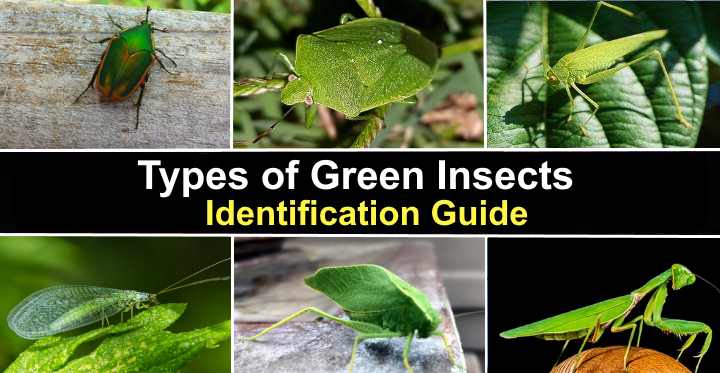
Green insects come in all shapes, sizes, and shades of green. Some common green insects such as grasshoppers, caterpillars, and lacewings have dark green to lime green bodies. Other insects, such as certain beetle species, have iridescent, metallic green bodies that seem to shimmer. Some butterfly species have fascinating neon green colors on their wings.
Insects—no matter what color they are—play a vital role in our planet’s ecosystem. Insects pollinate flowers, dispose of waste, and add to biodiversity. Some types of insects also produce things—for example, bees make honey, and silkworms produce silk. So, life would be much duller without insects.
Insects are classified and grouped by their order, family, genus, and species. The insect group or phylum is Arthropoda in the class Insecta. Then individual species are grouped by their genera. Some species of insects can be any color. However, some insects such as the praying mantis, grasshopper, and green stink bug are typically green.
Scientists estimate that there are over 900,000 kinds of insects and 30 million different insect species. It is estimated that there are 1.4 billion insects for every human on earth.
This article is a guide to identifying the most common green insects. Some of these green-colored insects you’ll see crawling or flying in gardens and parks. Other insects are more exotic and are rarely seen. You’ll also find out about light-green flies that are common household and garden pests.
Insect Identification
To identify insects, you must look at the number of legs and body parts they have. For example, all insects are identified by the fact they have three pairs of legs and three body parts—a head, thorax, and abdomen. Another feature that identifies insects is their two compound eyes.
Insects are also classified as invertebrates. This means that they have soft bodies without bones. Some creeping green insects like beetles and grasshoppers have an exoskeleton—a hard protective shell. Other flying insects such as aphids and butterflies have soft bodies.
Many adult insects also have wings, even though not all winged insects fly.
Caterpillars are an interesting example of crawling larval insects. Like all insect types, caterpillars have six proper legs—although they seem to have more, called prolegs. After metamorphosis, caterpillars change into flying winged insects with stunning wing patterns.
Insects vs. Bugs
What’s the difference between bugs and insects?
True bugs are classified in the order Hemiptera. Green insects that are called bugs include the green stink bug (Chinavia hilaris), aphids (Aphidoidea), and the Australian greengrocer (Cyclochila australasiae). Generally, true bugs consume food by piercing and sucking plant juices.
Other green insects such as grasshoppers (Caelifera), beetles (Coleoptera), and butterflies (Lepidoptera) are not true bugs. So, while all bugs are insects, not all insects are classified as bugs.
Spiders are neither bugs or insects. Species of spiders belong to the order Araneae. They differ from insects because they have eight legs, and their bodies only have two sections.
Types of Green Insects (With Name and Picture)
Let’s look in more detail at the different kinds of green insects such as grasshoppers, crickets, green stink bugs, aphids and more.
Grasshopper (Caelifera)
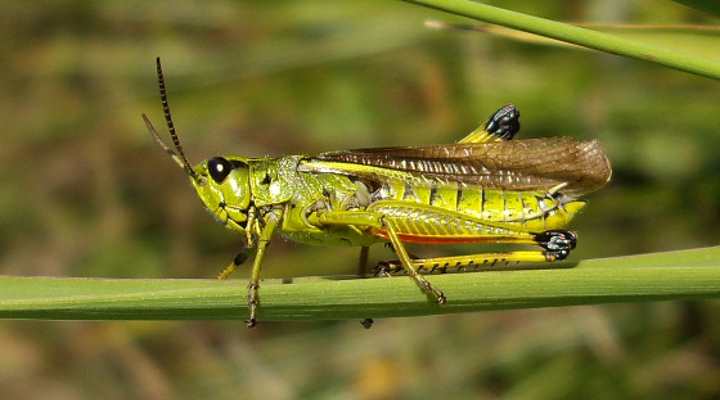
Grasshopper (Caelifera)
Grasshoppers are bright green jumping insects with long legs. Grasshoppers also have wings and fly. The green color of most grasshopper species camouflages them against plant foliage. Grasshoppers tend to lurk under foliage and among tall grass. You may spot signs of grasshopper activity by holes in crop leaves.
Grasshoppers can grow between 2” and 5” (5 – 12 cm) long.
Due to their insatiable appetite, grasshoppers can do a lot of damage in gardens, munching their way through plant leaves. But grasshoppers do the most destruction when they turn into flying green locusts. However, in large swarms, locusts turn dark brown or black.
Thankfully, grasshoppers are harmless to humans. Nevertheless, you probably want to get rid of these long-legged green insects from your garden—especially if you have many grasshoppers.
Related reading: How to get rid of grasshoppers.
Tree Crickets (Oecanthinae)

Tree Crickets (Oecanthinae)
Tree crickets are small flying pale green insects that also have long legs for jumping like grasshoppers. As their name suggests, tree crickets live in trees and shrubs where their lime green color makes them hard to spot. Tree crickets have three pairs of legs, two sets of wings, and two antennae.
Green tree crickets measure up to 2” (5 cm) in length thanks to their long hind legs.
Tree crickets are usually identified by the chirping noise they make. Interestingly, the frequencies of the chirps change according to the temperature.
Green Stink Bug (Chinavia hilaris)
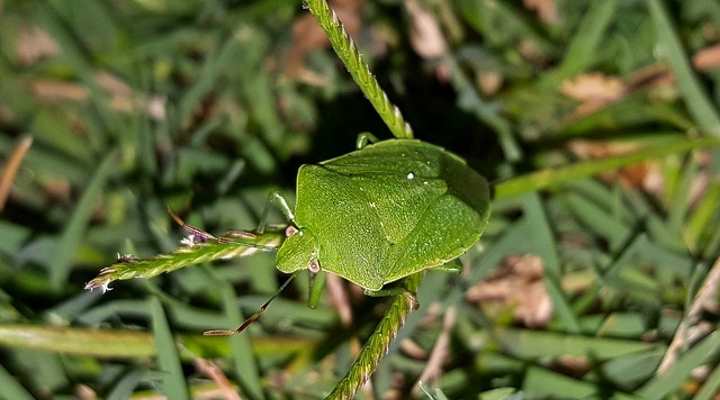
Green Stink Bug (Chinavia hilaris)
The green stink bug is an insect that looks like a bright green leaf in the shape of a shield. Also called the green soldier bug, green stink bugs are crawling insects that can be identified by the foul-smelling scent they emit when disturbed. The green stink bug also has six slender legs that it uses to crawl around foliage.
As with most types of true bugs, the green stink bug can become a crop pest. These leaf-like green bugs use piercing mouthpieces to suck juices from vegetables, fruit, stems, and foliage.
Green stink bugs also have two pairs of wings and fly. Their rigid, shield-like back protects the wings—one reason they’re also called shield bugs. You can identify adult stink bugs because the nymphs don’t have fully developed wings.
Green Butterflies
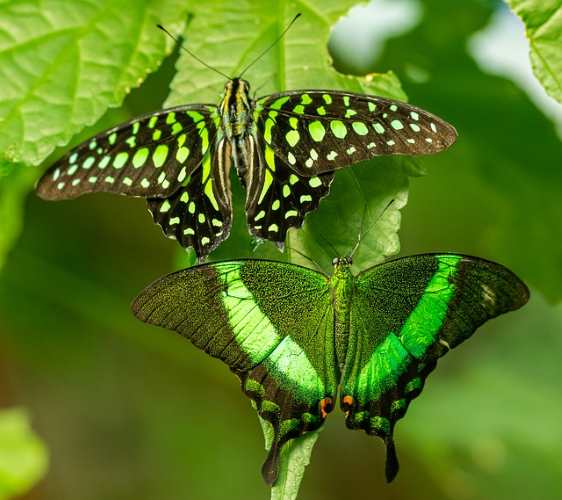
Tailed Jay green butterfly (top) and Emerald Swallowtail (bottom)
Some species of green butterflies have striking black and green markings on their wings. Butterflies are soft-bodied flying insects with four wings, three pairs of legs, and two antennae. It’s easy to identify butterflies from moths as they’re very colorful, have smoother abdomens, feed during the daytime, and rest with their wings facing upward.
The Emerald Swallowtail butterfly has black wings with an almost luminous bright green stripe on each wing. Close-up pictures of this green butterfly also reveal faint green speckles on the wings.
The Tailed Jay green butterfly has green and black wings with green dots and blotches, creating an interesting pattern.
Other green butterflies have spectacular metallic green coloring on the wings that seem to change color as they flutter in gardens.
Praying Mantis
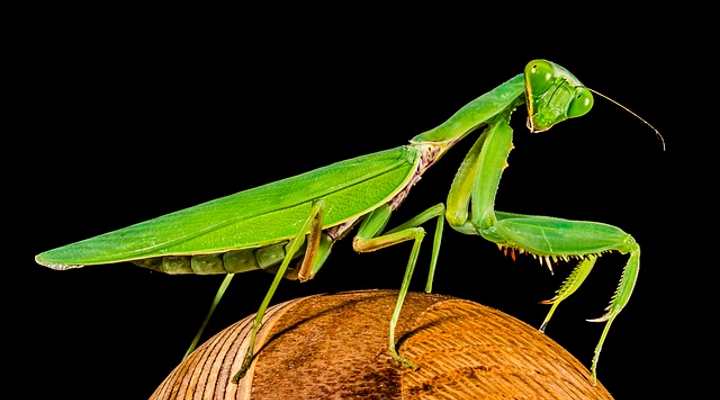
Praying Mantis
The praying mantis is a tropical green insect in the order Mantodea. The praying mantis is characterized by its triangular head, a set of antennae, two pairs of legs that it stands on, and a pair of grasping forelegs. Many species of mantis have wings, whereas some are wingless insects.
The common name of these green insects (praying mantis) comes from the distinctive way they hold their front legs in a praying position.
A praying mantis is a popular type of insect to keep as a pet. Mantises are ambush insects that lie in wait to attack their prey—the green insects are sometimes named the preying mantis. These insects feed on other insects such as crickets, flies, moths, and grasshoppers.
Green Lacewing (Chrysoperla rufilabris)

Green Lacewing (Chrysoperla rufilabris)
Green lacewings are flying insects with bright green to greenish-brown bodies. Lacewings are identified by slender bodies, translucent iridescent wings, and large golden compound eyes. Up close, you’ll notice green veins and faint patterns on the insect’s wings. Another feature of green lacewings is the unpleasant stink they give off when handled.
Green lacewings are classed as beneficial insects as they feed on common garden pests such as thrips, aphids, spider mites, mealybugs, and thrips. If you grow greenhouse crops, lacewings are excellent predator insects to help control plant-eating bugs.
Katydids (Tettigoniidae)
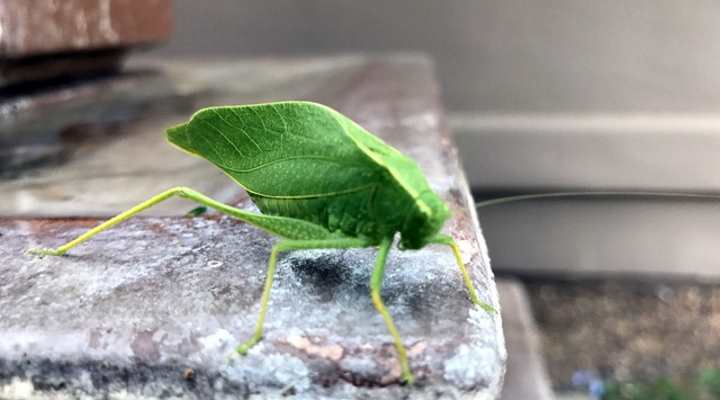
Katydids (Tettigoniidae)
Katydid is a type of green hopping insect that looks like a shiny green leaf. Also called bush crickets, katydid species use their green colors and wing shapes as camouflage to blend in with leaves and plant foliage. From the side, pictures of these bright green insects show they resemble a leaf.
A notable feature of broad-winged katydids is the chirping noises they make like crickets. These noisy, chirping insects typically ‘sing’ at night. Like crickets, the chirp frequencies change with the temperature.
Like many destructive green insects, katydids can do some damage to crop leaves and plant foliage. The plant-chewing insects gorge on leaves. However, compared to grasshoppers, katydids aren’t as destructive. Some gardeners consider katydids beneficial insects because they feed on aphids, thrips, and spider mites.
Although katydids look like green grasshoppers, you can tell the insects apart by their antennae. Katydids have long, slender arching antennae that can be longer than their body. However, grasshoppers have short, thick antennae.
Aphids (Aphiodiodea)
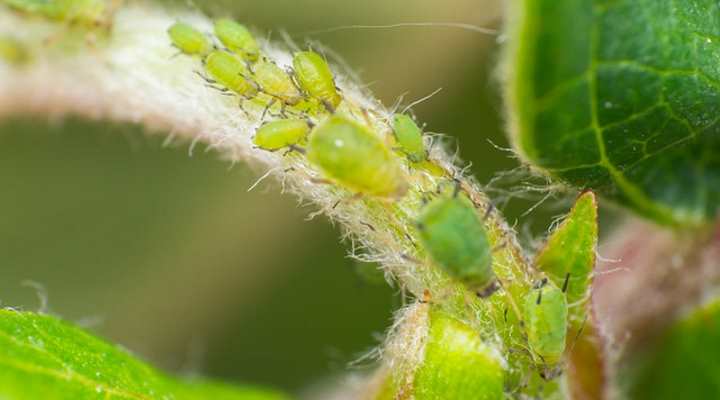
Aphids (Aphiodiodea)
Aphids are destructive small green insects that suck sap from plants. Green aphids have an almost translucent soft green body and are difficult to spot. Because some species grow wings, they are also called greenflies. These nasty sap-sucking green bugs swarm around plants and lurk beneath foliage.
Although they only measure 2 to 3 mm long, a large infestation can weaken plant growth. The continual feeding by these flying, plant-destroying insects can cause plant leaves to become wrinkled and fall off.
To look for signs of these tiny green bugs, look for aphids under plant leaves. They have pear-shaped bodies and can be green, black, yellow, or brown. Other signs of aphid activity are sticky, honeydew substance on plants and yellow curling leaves.
Aphids can be a real pest on houseplants, greenhouse crops, or garden shrubs.
Find out how to get rid of aphids naturally.
Green Beetles

Cucumber beetle (Chrysomelidae)
Green beetles look like bugs, but they are classed in the insect order Coleoptera. There are over 400,000 species of beetles, with weevils being the largest group. Beetles have all the classic characteristics of an insect—six legs, three body parts, two antennae, and an exoskeleton.
Many species of green beetle, such as leaf beetles, use their green coloring to blend into their surroundings. Other beetle species are recognized by their metallic green iridescent color, which also acts as an effective form of camouflage.
Some people mistake one type of green beetle for a green ladybug. However, the small green bug is the cucumber beetle (Chrysomelidae) that looks like a ladybug due to its oval green back and black dots.
Let’s look at a few common types of green beetles.
Pale Green Weevil Beetle (Polydrusus impressifrons)
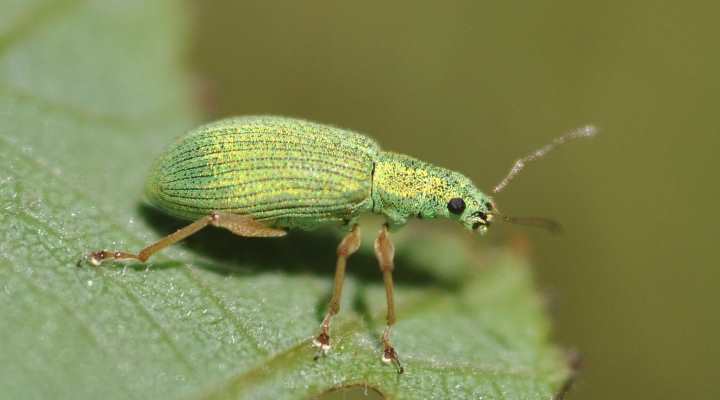
Green weevil beetle (Polydrusus impressifrons)
The green weevil beetle is a slender pale green insect with a shiny body and spindly brown legs. Also called leaf weevils, this green beetle is classed as a broad-nosed weevil in the beetle family Curculionidae. Its green colors act as camouflage when crawling on plant foliage.
Although green weevils eat leaves, they are not considered destructive insects.
Green June Beetle (Cotinis nitida)
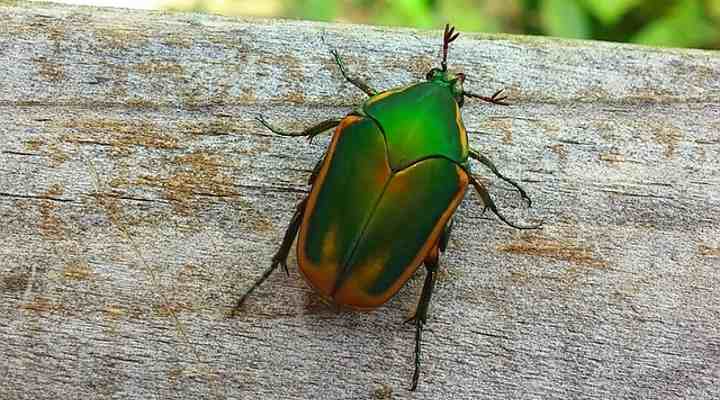
Green June Beetle (Cotinis nitida)
The green June beetle has a wide body that has dull, metallic green and bronze coloring. The iridescent greenish-brown colors are effective camouflage amongst green foliage and plant twigs and stems. Also called June bugs, the underside of these beetles is a bright shiny green color.
Green June beetles can cause some damage to fruit. Green June beetles also go by the name ‘Fig-Eater’ beetles as they feed on fresh figs. However, the green beetles will also eat any sweet, soft-skinned fruit. Apart from spoiling a fruit’s appearance, they leave a pungent bad-tasting substance that ruins the taste.
Glorious Beetle (Chrysina gloriosa)
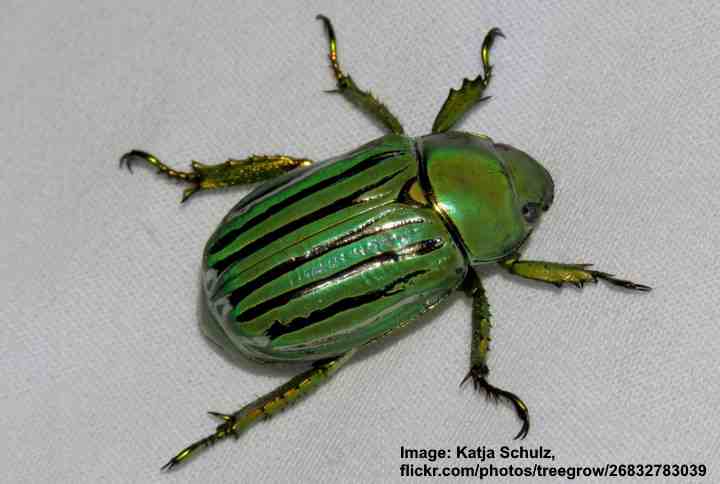
Glorious Beetle (Chrysina gloriosa)
The glorious beetle is a brightly-colored large green beetle with six spiny legs and a broad, stout body. The identifying feature of glorious beetles is their black or golden stripes on a shiny emerald-green body. Like other types of green beetle, this majestic species uses its colors as camouflage.
Glorious beetles are also classified as scarab beetles as they belong to the insect family Scarabaeidae.
Ambush Bugs (Amblythyreus)
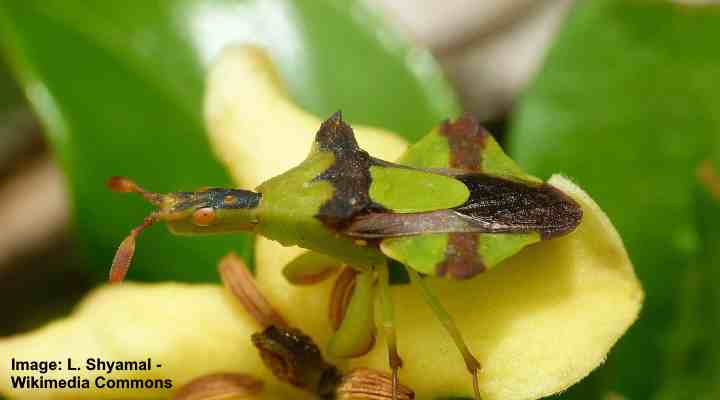
Ambush Bugs (Amblythyreus)
Ambush bugs are classified as a true bug in the order Hemiptera. This type of bug lies in wait, ready to pounce on its prey. The ambush bug changes its color to camouflage with its surroundings. So, on green foliage, the killer bug takes on green and brown colors so that unsuspecting insects won’t notice it.
The identifying characteristic of ambush bugs is their strong raptorial forelegs that they use to catch prey.
Green Caterpillars
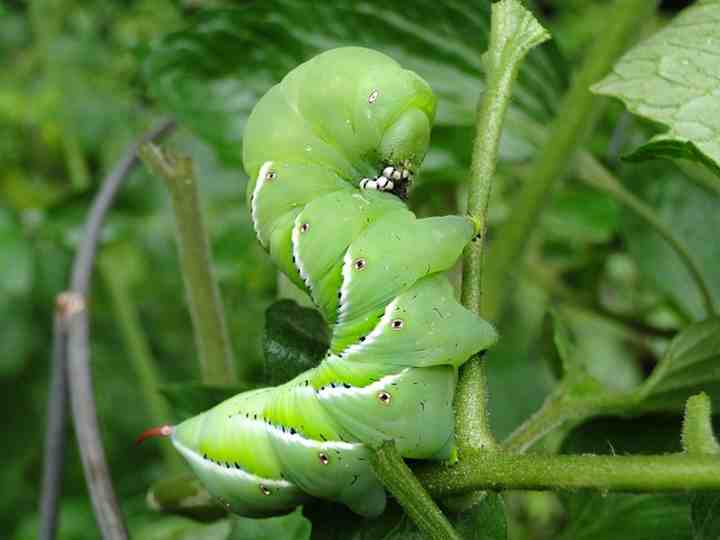
Green Tomato Hornworm Caterpillar
The apparent identifying feature of green caterpillars is their green color. Green caterpillars are crawling insects that come in varying shapes and sizes. Some are plump with plain lime green segmented bodies. Other types of caterpillars have long, bright green bodies with various colored markings and spiny segments. You’ll also find some fat green caterpillars with a horned tail.
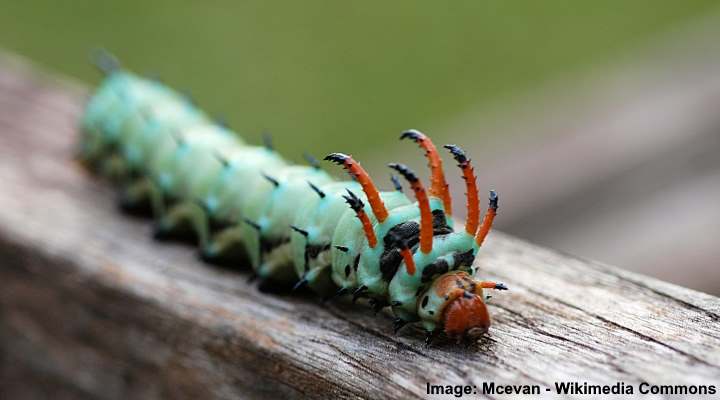
Green hickory horned devil caterpillar
One of the scariest caterpillars is the green hickory horned devil moth caterpillar. This long, fat green-bluish insect has menacing spiky red horns and a turquoise-green body. However, despite its evil look, this caterpillar is very placid.
Related reading: How to identify species of green caterpillars.
Related articles:
